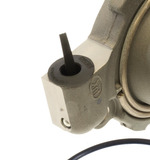I installed a new clutch with the slave cylinder.
Slave cylinder looks like this, the bottom right is where the bleed pipe goes.

I am trying to two-man method to bleed the clutch cylinder.
Initially after trying a few times it bleeds correctly (fluid and air come out), the clutch pedal gets harder after a few rounds then goes back down to the floor.
I saw that fluid was leaky through the transmission housing so remove it again to confirm, and there was fluid inside but could be incidental from some of the fluid during bleeding dripping through the disconnection valve.
The line that attaches to the slave cylinder (bottom right port) is installed securely, I reinstalled the bleed pipe again securely to the slave cylinder.
Not sure but there is a tiny port (relief valve?) on the other side of the slave cylinder that might have something to do with it, but I don't think so.
I didn't do anything with it, I just installed the part as it came.

Anyways, the bleed pipe looks like this

The other end goes to the disconnection valve that is on the outside of the transmission housing.

There is also the clutch hydraulic line. The o-ring initially looks fine, but I should I still replace it to confirm?

The two man bleeding method does seem to work but then fails later on, and clutch pedal becomes floppy again.
So either the two man bleeding just won't work in this case or there is really a leaky at the slave cylinder, or somewhere.
Any ideas would be helpful. Thank you
Slave cylinder looks like this, the bottom right is where the bleed pipe goes.
I am trying to two-man method to bleed the clutch cylinder.
Initially after trying a few times it bleeds correctly (fluid and air come out), the clutch pedal gets harder after a few rounds then goes back down to the floor.
I saw that fluid was leaky through the transmission housing so remove it again to confirm, and there was fluid inside but could be incidental from some of the fluid during bleeding dripping through the disconnection valve.
The line that attaches to the slave cylinder (bottom right port) is installed securely, I reinstalled the bleed pipe again securely to the slave cylinder.
Not sure but there is a tiny port (relief valve?) on the other side of the slave cylinder that might have something to do with it, but I don't think so.
I didn't do anything with it, I just installed the part as it came.
Anyways, the bleed pipe looks like this
The other end goes to the disconnection valve that is on the outside of the transmission housing.
There is also the clutch hydraulic line. The o-ring initially looks fine, but I should I still replace it to confirm?
The two man bleeding method does seem to work but then fails later on, and clutch pedal becomes floppy again.
So either the two man bleeding just won't work in this case or there is really a leaky at the slave cylinder, or somewhere.
Any ideas would be helpful. Thank you

